CHEVROLET LOW CAB FORWARD 2017 Workshop Manual
Manufacturer: CHEVROLET, Model Year: 2017, Model line: LOW CAB FORWARD, Model: CHEVROLET LOW CAB FORWARD 2017Pages: 414, PDF Size: 7.97 MB
Page 51 of 414

Chevrolet Low Cab Forward Owner Manual (GMNA-Localizing-U.S.-
10716700) - 2017 - crc - 12/6/16
50 Seats and Restraints
Warning (Continued)
do not use a seat belt if it does
not fit snugly over the child's hips
because restraining the child
under those conditions could be
dangerous in the event of a
collision or sudden stop. Instead,
use an appropriate child restraint
system available on the market.
For further details, please contact
your dealer.
Use a child restraint system that
fits the size of the infant or child.
Install the system according to
the manufacturer's instructions.
Children who have outgrown child
restraint systems should use the
vehicle's seat belts.
Remove any twists in the seat
belt before fastening it. A seat
belt with twists will not provide full
protection because it cannot
disperse shocks efficiently in the
event of a collision or
sudden stop.(Continued)
Warning (Continued)
Too much slack could increase
the amount of injury because the
belt would not be able to properly
restrain you in an accident.
Do not put the lap portion of a
seat belt over any armrest.
Do not wear a shoulder belt under
your arm nearest the door.
Do not let a buckle release button
face downward or inward.
Expectant mothers or people
suffering from chest or abdominal
conditions should check with their
doctor for specific
recommendations about wearing
seat belts.
Do not use one seat belt for more
than one person. If worn by more
than one person, the seat belt
would not work effectively in a
collision or sudden stop.(Continued)
Warning (Continued)
Have seat belts inspected and,
if necessary, replaced by the
nearest dealer when the webbing
becomes frayed or worn and/or
when the buckle or other
mechanical parts fail to work
properly.
If your vehicle has been involved
in a collision, the seat belts worn
at the time may have lost their
original strength due to impact
even if they appear intact. These
seat belts must be inspected and,
if necessary, replaced by the
nearest dealer.
Be careful to keep the buckles
and retractors free of dust and
foreign matter. (This may jam the
retractor or damage the belt.)
Do not let the belt system
become damaged by the door
or seat.
(Continued)
Page 52 of 414
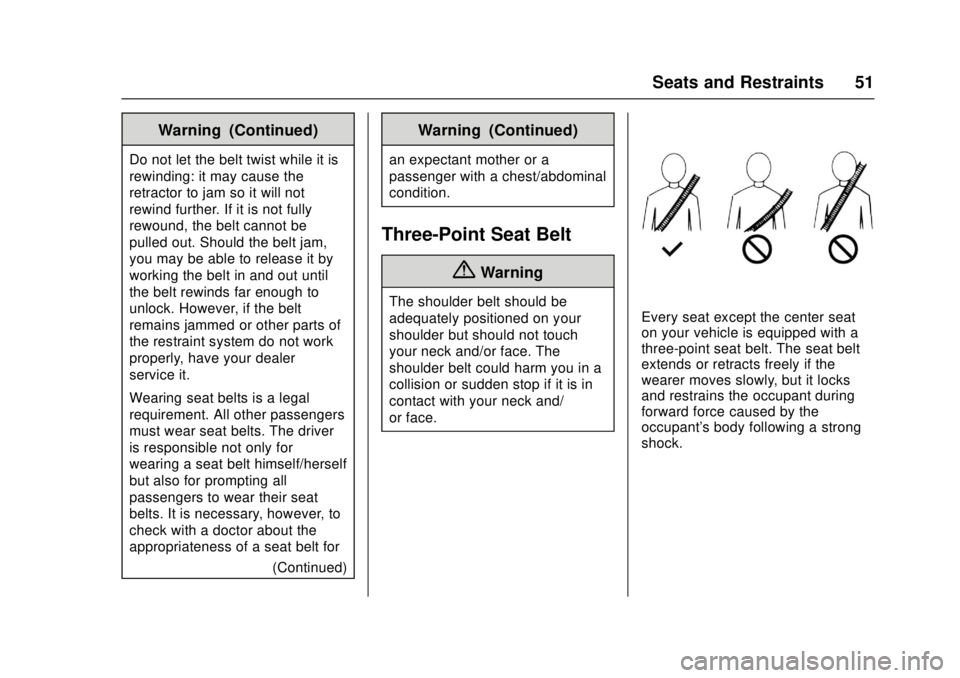
Chevrolet Low Cab Forward Owner Manual (GMNA-Localizing-U.S.-
10716700) - 2017 - crc - 12/6/16
Seats and Restraints 51
Warning (Continued)
Do not let the belt twist while it is
rewinding: it may cause the
retractor to jam so it will not
rewind further. If it is not fully
rewound, the belt cannot be
pulled out. Should the belt jam,
you may be able to release it by
working the belt in and out until
the belt rewinds far enough to
unlock. However, if the belt
remains jammed or other parts of
the restraint system do not work
properly, have your dealer
service it.
Wearing seat belts is a legal
requirement. All other passengers
must wear seat belts. The driver
is responsible not only for
wearing a seat belt himself/herself
but also for prompting all
passengers to wear their seat
belts. It is necessary, however, to
check with a doctor about the
appropriateness of a seat belt for(Continued)
Warning (Continued)
an expectant mother or a
passenger with a chest/abdominal
condition.
Three-Point Seat Belt
{Warning
The shoulder belt should be
adequately positioned on your
shoulder but should not touch
your neck and/or face. The
shoulder belt could harm you in a
collision or sudden stop if it is in
contact with your neck and/
or face.Every seat except the center seat
on your vehicle is equipped with a
three-point seat belt. The seat belt
extends or retracts freely if the
wearer moves slowly, but it locks
and restrains the occupant during
forward force caused by the
occupant's body following a strong
shock.
Page 53 of 414

Chevrolet Low Cab Forward Owner Manual (GMNA-Localizing-U.S.-
10716700) - 2017 - crc - 12/6/16
52 Seats and Restraints
To Fasten:1. Sit on the seat in the correct driving position.
2. Pull out the seat belt holdingthe latch plate. After checking
that there are no twists in the
belt, insert the latch plate into
the buckle until it clicks. If the
retractor locks before the latch
plate reaches the buckle, let
the belt retract slightly, then
withdraw it slower than before.
3. To reduce the risk of slidingunder the belt during a
collision, position the belt
across your lap as low on your
hips as possible and adjust it to
a snug fit by pulling the
"shoulder" portion upward
through the latch plate.
The lap-shoulder belt is
designed to lock during a
sudden stop or impact. At other
times it should move freely. To Unfasten:
Push the button on the buckle. As
the belt automatically retracts, let it
be taken up slowly by holding on to
the latch plate until the belt is fully
retracted.
While being automatically retracted,
the seat belt could damage a
nearby window or interior trim
unless the latch plate is properly
held. Hold the latch plate to ensure
that the belt is taken up slowly.
Before closing the door, check that
the retracted seat belt is taut.
A slack belt could become trapped
in the door or seat rail.
Page 54 of 414

Chevrolet Low Cab Forward Owner Manual (GMNA-Localizing-U.S.-
10716700) - 2017 - crc - 12/6/16
Seats and Restraints 53
When the passenger's seat belt is
fully taken up (or not pulled out),
check that the stopper is holding the
belt in a fully taut state.
Emergency Locking Retractor
(ELR) Function
The three-point seat belts are
provided with an Emergency
Locking Retractor (ELR) function.
The ELR normally allows the seat
belt to move in and out freely as the
occupant moves. However, it locks
the seat belt to restrain the
occupant when a forward force
resulting from a collision or sudden
stop acts on the occupant.
The ELR also locks the seat belt
when the belt is pulled out quickly.
If this happens, allow it to retract
once and then pull it out slowly.Seat Belt Use During
Pregnancy
{Warning
Unless the seat belt is correctly
worn, it may dig into the abdomen
in the event of hard braking or a
collision, harming not only the
expectant mother but also the
unborn child, putting them both in
danger of serious injuries or
death.
An expectant mother or a person
who is ill riding in the vehicle must
also wear a seat belt. In light of the
risk that the seat belt will apply
pressure to the abdomen, chest and
shoulders in the event of a collision,
however, an expectant mother or
person who is ill should get advice
from a physician beforehand.
.An expectant mother should use
a three-point seat belt.
. An expectant mother should
position the lap belt snugly as
low as possible on the hips (not
across the abdomen). Also, she
should fasten the shoulder belt
so it rests on her chest, not on
her abdomen.
Lap Belt
The center seat lap belt has no
retractor, but should be positioned,
worn, and released as described
below.
Page 55 of 414

Chevrolet Low Cab Forward Owner Manual (GMNA-Localizing-U.S.-
10716700) - 2017 - crc - 12/6/16
54 Seats and Restraints
To Fasten:1. Sit on the seat in the correct position.
2. Pull out the latch plate side ofthe belt a little longer than
necessary. Placing the latch
plate at right angles with the
belt makes this easier.
3. After checking that there are notwists in the belt, insert the
latch plate into the buckle until
it clicks.
4. Position the seat belt acrossthe lap as low as possible on
the hips. Pull the fold-back end
of the belt (upper side) until the
belt is adjusted to a snug fit.
To Unfasten:
Push the button on the buckle to
unfasten the belt.
The center seat belt
(length-adjustable two-point belt) is
designed so that it cannot be
connected with any of the
windowside seat belts (three-point
seat belts with ELR).
Page 56 of 414
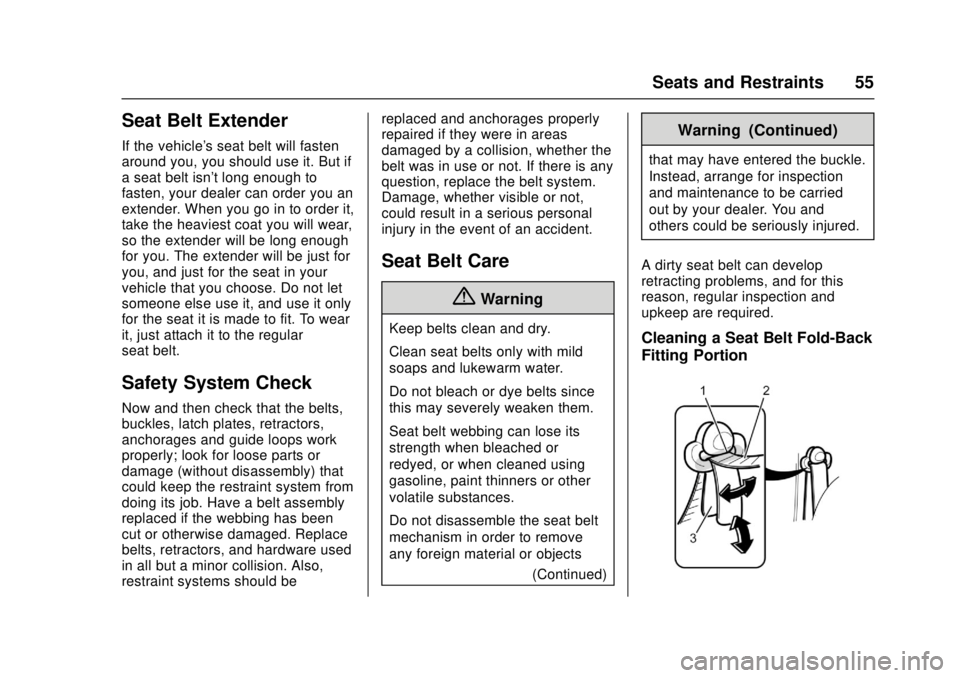
Chevrolet Low Cab Forward Owner Manual (GMNA-Localizing-U.S.-
10716700) - 2017 - crc - 12/6/16
Seats and Restraints 55
Seat Belt Extender
If the vehicle's seat belt will fasten
around you, you should use it. But if
a seat belt isn't long enough to
fasten, your dealer can order you an
extender. When you go in to order it,
take the heaviest coat you will wear,
so the extender will be long enough
for you. The extender will be just for
you, and just for the seat in your
vehicle that you choose. Do not let
someone else use it, and use it only
for the seat it is made to fit. To wear
it, just attach it to the regular
seat belt.
Safety System Check
Now and then check that the belts,
buckles, latch plates, retractors,
anchorages and guide loops work
properly; look for loose parts or
damage (without disassembly) that
could keep the restraint system from
doing its job. Have a belt assembly
replaced if the webbing has been
cut or otherwise damaged. Replace
belts, retractors, and hardware used
in all but a minor collision. Also,
restraint systems should bereplaced and anchorages properly
repaired if they were in areas
damaged by a collision, whether the
belt was in use or not. If there is any
question, replace the belt system.
Damage, whether visible or not,
could result in a serious personal
injury in the event of an accident.
Seat Belt Care
{Warning
Keep belts clean and dry.
Clean seat belts only with mild
soaps and lukewarm water.
Do not bleach or dye belts since
this may severely weaken them.
Seat belt webbing can lose its
strength when bleached or
redyed, or when cleaned using
gasoline, paint thinners or other
volatile substances.
Do not disassemble the seat belt
mechanism in order to remove
any foreign material or objects
(Continued)
Warning (Continued)
that may have entered the buckle.
Instead, arrange for inspection
and maintenance to be carried
out by your dealer. You and
others could be seriously injured.
A dirty seat belt can develop
retracting problems, and for this
reason, regular inspection and
upkeep are required.
Cleaning a Seat Belt Fold-Back
Fitting Portion
Page 57 of 414
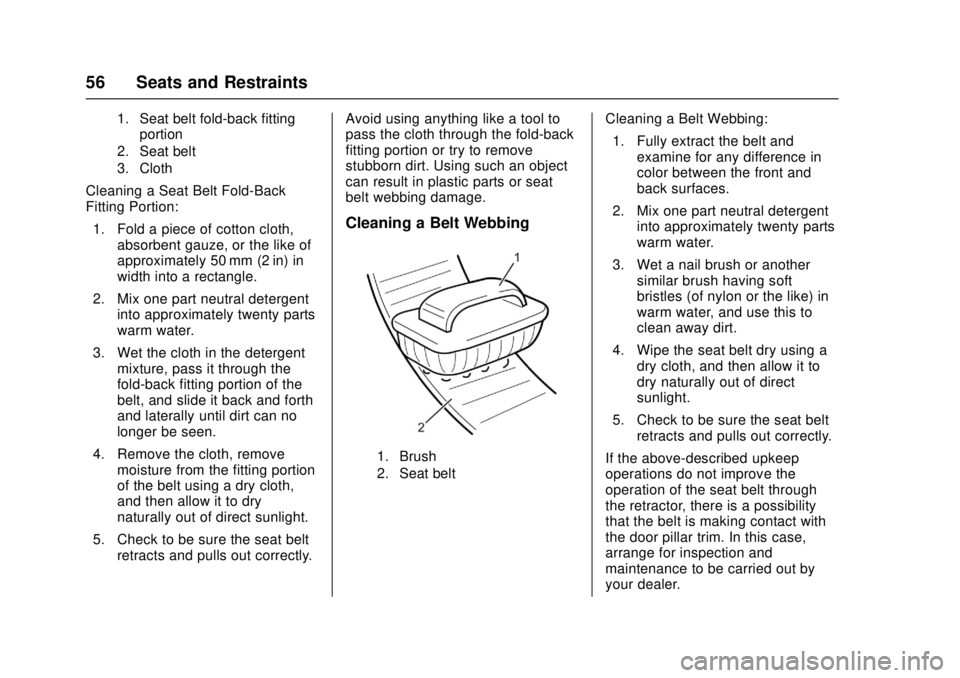
Chevrolet Low Cab Forward Owner Manual (GMNA-Localizing-U.S.-
10716700) - 2017 - crc - 12/6/16
56 Seats and Restraints
1. Seat belt fold-back fittingportion
2. Seat belt
3. Cloth
Cleaning a Seat Belt Fold-Back
Fitting Portion:
1. Fold a piece of cotton cloth, absorbent gauze, or the like of
approximately 50 mm (2 in) in
width into a rectangle.
2. Mix one part neutral detergent into approximately twenty parts
warm water.
3. Wet the cloth in the detergent mixture, pass it through the
fold-back fitting portion of the
belt, and slide it back and forth
and laterally until dirt can no
longer be seen.
4. Remove the cloth, remove moisture from the fitting portion
of the belt using a dry cloth,
and then allow it to dry
naturally out of direct sunlight.
5. Check to be sure the seat belt retracts and pulls out correctly. Avoid using anything like a tool to
pass the cloth through the fold-back
fitting portion or try to remove
stubborn dirt. Using such an object
can result in plastic parts or seat
belt webbing damage.
Cleaning a Belt Webbing
1. Brush
2. Seat belt
Cleaning a Belt Webbing:
1. Fully extract the belt and examine for any difference in
color between the front and
back surfaces.
2. Mix one part neutral detergent into approximately twenty parts
warm water.
3. Wet a nail brush or another similar brush having soft
bristles (of nylon or the like) in
warm water, and use this to
clean away dirt.
4. Wipe the seat belt dry using a dry cloth, and then allow it to
dry naturally out of direct
sunlight.
5. Check to be sure the seat belt retracts and pulls out correctly.
If the above-described upkeep
operations do not improve the
operation of the seat belt through
the retractor, there is a possibility
that the belt is making contact with
the door pillar trim. In this case,
arrange for inspection and
maintenance to be carried out by
your dealer.
Page 58 of 414
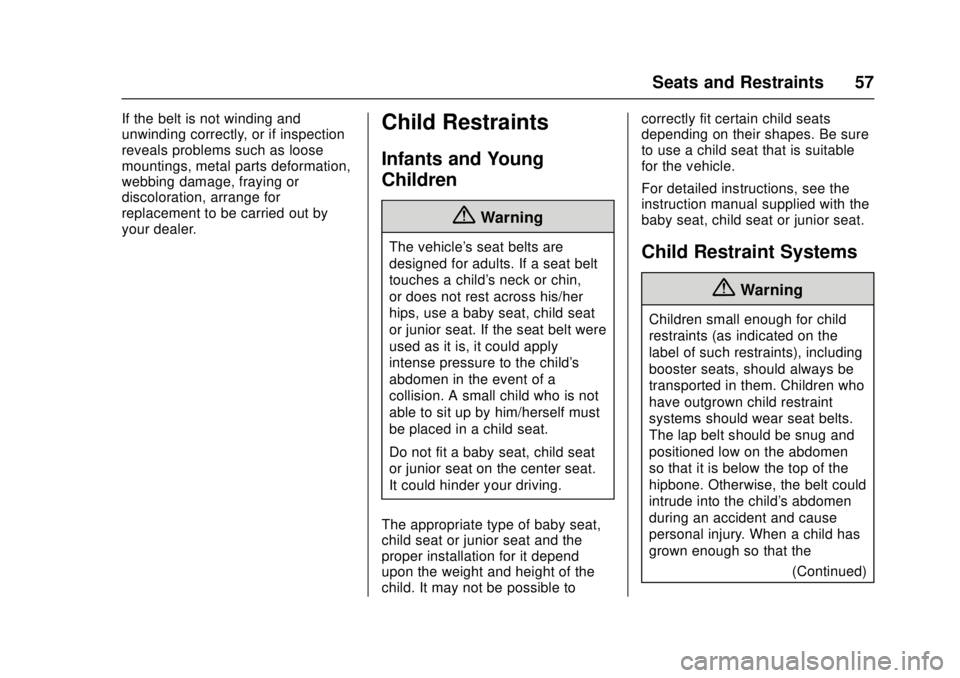
Chevrolet Low Cab Forward Owner Manual (GMNA-Localizing-U.S.-
10716700) - 2017 - crc - 12/6/16
Seats and Restraints 57
If the belt is not winding and
unwinding correctly, or if inspection
reveals problems such as loose
mountings, metal parts deformation,
webbing damage, fraying or
discoloration, arrange for
replacement to be carried out by
your dealer.Child Restraints
Infants and Young
Children
{Warning
The vehicle's seat belts are
designed for adults. If a seat belt
touches a child's neck or chin,
or does not rest across his/her
hips, use a baby seat, child seat
or junior seat. If the seat belt were
used as it is, it could apply
intense pressure to the child's
abdomen in the event of a
collision. A small child who is not
able to sit up by him/herself must
be placed in a child seat.
Do not fit a baby seat, child seat
or junior seat on the center seat.
It could hinder your driving.
The appropriate type of baby seat,
child seat or junior seat and the
proper installation for it depend
upon the weight and height of the
child. It may not be possible to correctly fit certain child seats
depending on their shapes. Be sure
to use a child seat that is suitable
for the vehicle.
For detailed instructions, see the
instruction manual supplied with the
baby seat, child seat or junior seat.Child Restraint Systems
{Warning
Children small enough for child
restraints (as indicated on the
label of such restraints), including
booster seats, should always be
transported in them. Children who
have outgrown child restraint
systems should wear seat belts.
The lap belt should be snug and
positioned low on the abdomen
so that it is below the top of the
hipbone. Otherwise, the belt could
intrude into the child's abdomen
during an accident and cause
personal injury. When a child has
grown enough so that the
(Continued)
Page 59 of 414
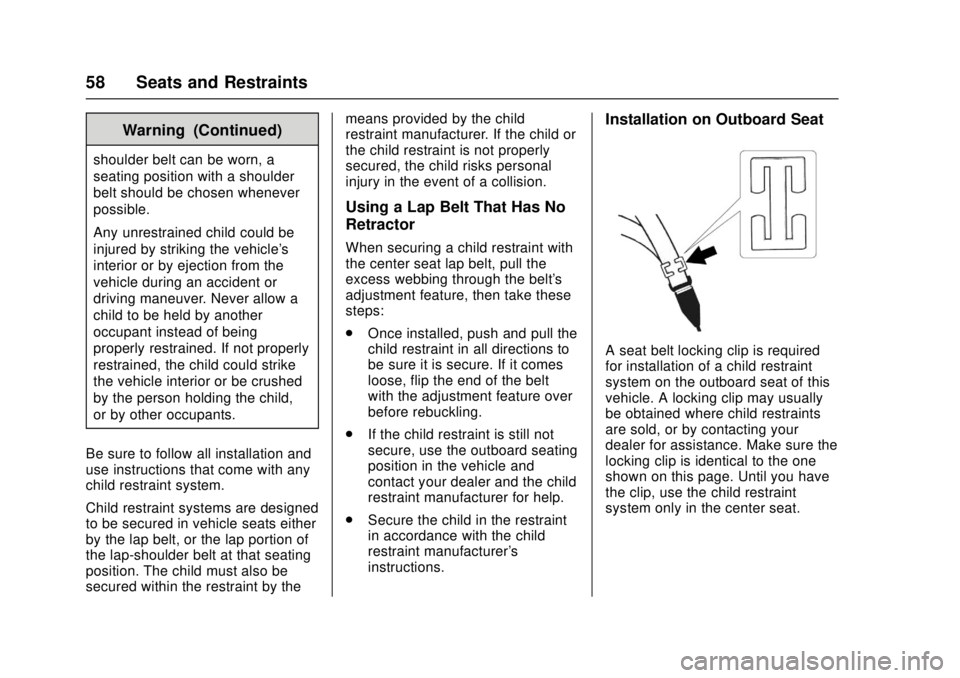
Chevrolet Low Cab Forward Owner Manual (GMNA-Localizing-U.S.-
10716700) - 2017 - crc - 12/6/16
58 Seats and Restraints
Warning (Continued)
shoulder belt can be worn, a
seating position with a shoulder
belt should be chosen whenever
possible.
Any unrestrained child could be
injured by striking the vehicle's
interior or by ejection from the
vehicle during an accident or
driving maneuver. Never allow a
child to be held by another
occupant instead of being
properly restrained. If not properly
restrained, the child could strike
the vehicle interior or be crushed
by the person holding the child,
or by other occupants.
Be sure to follow all installation and
use instructions that come with any
child restraint system.
Child restraint systems are designed
to be secured in vehicle seats either
by the lap belt, or the lap portion of
the lap-shoulder belt at that seating
position. The child must also be
secured within the restraint by the means provided by the child
restraint manufacturer. If the child or
the child restraint is not properly
secured, the child risks personal
injury in the event of a collision.
Using a Lap Belt That Has No
Retractor
When securing a child restraint with
the center seat lap belt, pull the
excess webbing through the belt's
adjustment feature, then take these
steps:
.
Once installed, push and pull the
child restraint in all directions to
be sure it is secure. If it comes
loose, flip the end of the belt
with the adjustment feature over
before rebuckling.
. If the child restraint is still not
secure, use the outboard seating
position in the vehicle and
contact your dealer and the child
restraint manufacturer for help.
. Secure the child in the restraint
in accordance with the child
restraint manufacturer's
instructions.
Installation on Outboard Seat
A seat belt locking clip is required
for installation of a child restraint
system on the outboard seat of this
vehicle. A locking clip may usually
be obtained where child restraints
are sold, or by contacting your
dealer for assistance. Make sure the
locking clip is identical to the one
shown on this page. Until you have
the clip, use the child restraint
system only in the center seat.
Page 60 of 414

Chevrolet Low Cab Forward Owner Manual (GMNA-Localizing-U.S.-
10716700) - 2017 - crc - 12/6/16
Seats and Restraints 59
{Warning
To help avoid personal injury or
death during a collision or sudden
maneuver, always thread both the
lap and shoulder belt through the
locking clip when securing a child
restraint on the outboard seat.
If the clip is not used or installed
properly, the child restraint may
move or tip over when your
vehicle turns or stops abruptly.
Secure the child restraint with the
lap belt portion (1) of the seat belt in
accordance with the restraintmanufacturer's instructions. Then
thread both the lap (1) and shoulder
belt (2) portions through the locking
clip. Push and pull the child restraint
in all directions to be sure it is
secure.
Locking Clip Attached to Seat Belt
–Side View
1. Lap Belt
2. Shoulder Belt
3. Locking Clip
When your child restraint is not
installed, remove the locking clip to
permit normal use of the lap-shoulder belt. Keep the locking
clip in the glove box to help prevent
its loss.
Child Restraint with Top Strap
{Warning
We do not recommend using a
child restraint that requires the
use of a top strap. There is no
appropriate place to attach a top
strap anchor behind the seat in
this vehicle.